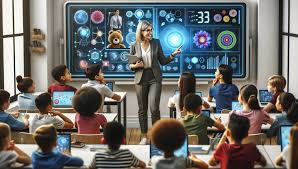The Role of AI in Modern Classrooms
Artificial Intelligence (AI) is revolutionizing numerous industries, and education is no exception. As technology continues to advance, AI is playing an increasingly important role in modern classrooms, transforming the way students learn and teachers instruct. From personalized learning experiences to administrative tasks, AI tools are enhancing both teaching and learning. This article explores the diverse applications of AI in education and its potential to shape the future of classrooms.
1. Personalized Learning Experiences
One of the most significant ways AI is impacting modern classrooms is through personalized learning. Traditional teaching methods often adopt a “one-size-fits-all” approach, which may not cater to the unique needs of each student. AI, however, allows for customization of learning experiences based on individual student abilities, preferences, and learning styles.
How AI Personalizes Learning:
- Adaptive Learning Software: AI-driven platforms can assess a student’s current understanding of a topic and adjust the difficulty of tasks accordingly. This ensures that students are always challenged at the right level.
- Tailored Content: AI can recommend learning materials—such as videos, articles, and quizzes—based on a student’s specific needs, ensuring that they receive the most relevant resources.
- Learning Pace: AI allows students to progress at their own speed, enabling them to spend more time on challenging areas and moving quickly through concepts they already understand.
By providing a tailored experience, AI enhances student engagement and helps educators identify areas where students may need additional support.
2. Intelligent Tutoring Systems
AI-powered tutoring systems offer personalized assistance, supplementing traditional classroom teaching. These systems can be available around the clock, offering students extra help outside of regular class hours.
Benefits of Intelligent Tutoring Systems:
- 24/7 Availability: Students can access tutoring support anytime, allowing them to get help when needed, even after school hours.
- Instant Feedback: AI tutors can instantly assess student responses, providing immediate feedback, explanations, and solutions to problems.
- Continuous Learning: With AI tutors, students can practice concepts and reinforce their learning without waiting for human intervention, leading to better retention and understanding.
By offering immediate, personalized assistance, AI tutoring systems play a vital role in improving student performance and boosting their confidence in challenging subjects.
3. AI in Classroom Management
Classroom management can be one of the most challenging aspects of teaching. AI can streamline and simplify administrative tasks, freeing up more time for teachers to focus on instruction and student interaction.
How AI Enhances Classroom Management:
- Attendance Monitoring: AI-powered systems can track attendance through facial recognition or other biometric technologies, automating the attendance process and reducing administrative burden.
- Behavior Analysis: AI tools can monitor student behavior, identifying patterns or issues that may require attention. By tracking individual or group behavior, teachers can address concerns proactively.
- Task Automation: AI can automate tasks such as grading and assignment feedback, giving teachers more time to engage with students and prepare for lessons.
With AI handling administrative tasks, teachers can spend more time focusing on teaching, creating a more effective and efficient learning environment.
4. Enhancing Student Engagement with AI
Keeping students engaged in the classroom can be a difficult task, especially in the digital age when distractions are abundant. AI can support educators in creating more interactive and engaging lessons that capture students’ attention and foster deeper learning.
Ways AI Boosts Engagement:
- Gamification: AI-driven educational games make learning more fun and interactive by incorporating rewards, challenges, and real-time feedback, which can motivate students to stay engaged.
- Virtual and Augmented Reality: AI combined with VR/AR technologies can immerse students in interactive, hands-on learning experiences, making complex concepts more accessible and enjoyable.
- Interactive Content: AI can create interactive simulations and personalized quizzes, making learning more dynamic and allowing students to actively participate in their education.
By incorporating AI into lessons, educators can increase engagement and help students retain information in more innovative and memorable ways.
5. Real-Time Data and Analytics for Teachers
AI-powered tools provide real-time insights into student performance, allowing teachers to make informed decisions and adjust their teaching methods accordingly. These data-driven insights can enhance both teaching and learning outcomes.
Benefits of Real-Time Analytics:
- Performance Tracking: AI can track individual student performance across various subjects, offering insights into areas of strength and weakness.
- Predictive Analytics: AI can predict which students may be at risk of falling behind, allowing teachers to intervene early and provide additional support.
- Progress Reports: AI systems can generate comprehensive progress reports, enabling teachers to monitor class performance and tailor their lessons to meet students’ needs.
With access to real-time data, teachers can identify trends, personalize instruction, and intervene when necessary, leading to better student outcomes.
6. AI in Special Education
AI offers tremendous potential for supporting students with special needs, providing customized tools and resources to meet their unique learning challenges. From speech recognition tools to personalized learning plans, AI helps level the playing field for students with disabilities.
Ways AI Supports Special Education:
- Speech and Language Tools: AI-driven speech recognition software can help students with language impairments by transcribing speech to text and offering language support.
- Assistive Technologies: AI-powered devices can assist students with visual or hearing impairments by providing real-time translation, transcription, or other adaptive services.
- Personalized Learning Plans: AI can create individualized learning plans for students with special needs, ensuring that their educational experience is tailored to their specific requirements.
AI’s ability to provide personalized support for students with disabilities helps ensure that all students have access to an inclusive, high-quality education.
7. Preparing Students for Future Careers
AI not only impacts current education but also plays a role in preparing students for future careers. By incorporating AI tools into the curriculum, students gain exposure to cutting-edge technologies and skills that will be valuable in the workforce.
How AI Prepares Students for Future Careers:
- Coding and AI Literacy: Schools are integrating AI and coding into the curriculum, providing students with the knowledge and skills needed for careers in tech.
- Problem-Solving and Critical Thinking: AI promotes problem-solving skills by encouraging students to use AI tools to solve complex challenges, which are essential for many future careers.
- Innovation and Creativity: AI encourages students to think creatively by exploring new possibilities and using technology in innovative ways, preparing them for careers in a variety of fields.
By introducing students to AI technology, educators can equip them with the skills necessary to succeed in an increasingly digital world.
8. Ethical Considerations and Challenges of AI in Education
While AI offers many benefits, it’s important to address the ethical concerns and challenges associated with its integration into education.
Key Concerns:
- Privacy and Security: The use of AI in classrooms raises concerns about the collection and storage of personal data. Schools must ensure that AI systems comply with data protection regulations to protect students’ privacy.
- Bias and Fairness: AI systems can inherit biases from the data they are trained on. It’s essential to ensure that AI tools used in education are free from bias and provide equal opportunities for all students.
- Teacher-Student Relationship: There are concerns that AI may reduce human interaction in the classroom, potentially impacting the teacher-student relationship. It’s important to maintain a balance between AI technology and the human touch in education.
Despite these challenges, AI has the potential to significantly enhance education when implemented thoughtfully and ethically.
Final Thoughts
AI is rapidly transforming the educational landscape, offering students and teachers new tools for learning and teaching. From personalized learning experiences to advanced classroom management, AI is helping to improve both academic performance and student engagement. However, its successful integration requires careful planning, ethical considerations, and a balanced approach to ensure that AI enhances the educational experience rather than replacing the human connection at the core of learning. As AI continues to evolve, its role in education will only expand, shaping the future of classrooms worldwide.










Leave a Comment